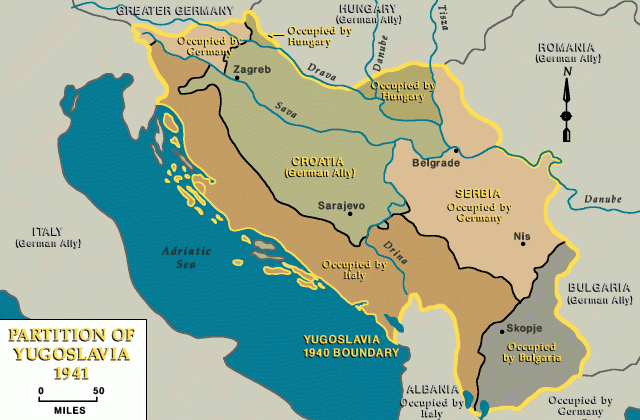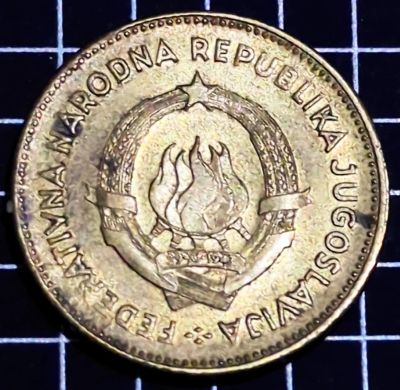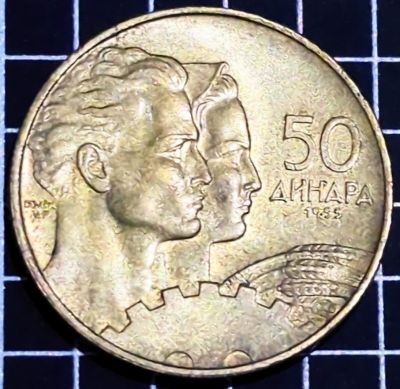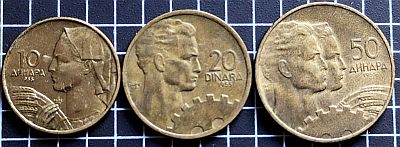A socialist coin from a series which works well together.
1946-63 Emblem of Federal People’s Republic (FPR) of Yugoslavia. Image from Wikipedia.
Writing about the 1931 Yugoslavia 10 Dinara, I covered some of the early history of Yugoslavia – at least up to the creation of Yugoslavia as a dictatorship under King Alexander. This particularly angered many of the Croats. The Croatian Ustasha rebel party was created. Outlawed by the King, they fled to fascist Italy, under the protection of Benito Mussolini.
In 1934, King Alexander was assassinated in France by the rebels, as the French tried to build an alliance of allies including Yugoslavia, Italy and the Soviet Union with the goal of containing Germany. By 1939, following the rise of Nazi Germany, Yugoslavia created the autonomous Banovina of Croatia. This did not build the desired unity, but this time provoked resentment among the Serbs.
In March 1941, Yugoslavia joined the Axis and agreed to permit transit through its territory to German troops headed for Greece. There were large scale demonstrations in Belgrade. A coup, organised by Serbs and backed by the British, saw former King Alexander’s son Paul seize power (he had previously been too young but was now 17) and withdraw support for Germany. Hitler was furious, and the Axis powers consequently invaded Yugoslavia, conquering it, and King Paul fled to Kenya.

(Partition of Yugoslavia in 1941, from the Holocaust Encyclopedia)
The Axis powers, Germany, Italy, Hungary and Bulgaria all annexed parts of Yugoslavia, and an expanded Croatia was recognised by the Axis as an independent state. King Peter supported the anti-German, anti-communist Cetnik opposition force. A separate, pro-communist opposition led by Josip Broz Tito became the stronger opposition and attracted Allies support.
Following the defeat of the Axis in 1945, Tito’s communist party took power, abolished the monarchy and declared the Federal People’s Republic (FPR) of Yugoslavia. The new republic closely followed the Stalinist Soviet model, and the country was allied with Stalin’s Soviet Union. In 1948, conflict with the Soviet Union, known as the Informbiro Period, led to Yugoslavia being expelled from the Soviet Union. This was largely caused by Josip Bros Tito’s unwillingness to obey the instructions of Stalin. Moscow considered “Titoism” treasonous and party purges against suspected Titoites were conducted throughout Eastern Europe. Stalinist Yugoslavs were angry and endeavoured to stir unrest, while Yugoslavia accepted closer ties with the United States. Yugoslavia were unwilling to join NATO, or the communist Warsaw Pact.
Yugoslavia began a series of reforms in the early 1950s, beginning with workers’ self-management. This demonstrated the viability of a socialist “third way” between the capitalist United States and the communist Soviet Union.
Obverse

The obverse contains the country name around the coat-of-arms. It featured five torches surrounded by wheat and burning together in one flame; this represented the brotherhood and unity of the five nations of SFRY: Croats, Macedonians, Montenegrins, Serbs and Slovenes. The Bosniaks were not represented as a constituent nation.
Reverse

The reverse features a “Man and woman looking right, ears of wheat and cogwheel”. The value and year are to the right. This is a very socialist image, showing the elements of production, and the workers who owned it. One of my favourite parts however, is how it fits into the series of coins issued in 1955:
The 10 Dinara features a woman and a sheaf of wheat. The 20 Dinara features a man and a cog. This 50 Dinara brings all of those elements from the smaller coins together.

I really like when a series of coins works together like this. What is your favourite series which all fit together neatly like this?


Leave a Reply